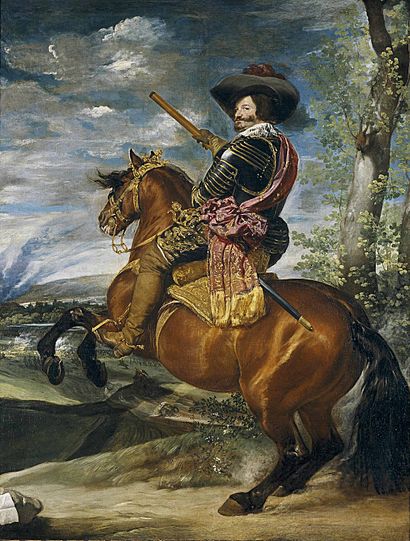Equestrian Portrait of the Count-Duke of Olivares facts for kids
Quick facts for kids Equestrian Portrait of the Count-Duke of Olivares |
|
|---|---|
 |
|
| Artist | Diego Velázquez |
| Year | c. 1636 |
| Medium | oil paint, canvas |
| Dimensions | 313 cm (123 in) × 239 cm (94 in) |
| Location | hall 012, Royal Palace of Madrid |
| Owner | Ferdinand VII of Spain |
| Collection | Museo del Prado |
| Accession No. | P001181 |
| Identifiers | RKDimages ID: 223308 |
This famous painting, called Gaspar de Guzmán, Count-Duke of Olivares, on Horseback, was created by the Spanish artist Diego Velázquez. He painted it around 1636. Today, you can see it at the Museo del Prado in Madrid, Spain.
This painting is special because it looks more powerful and colorful than many of Velázquez's other works. The main goal of the painting was to show how important and strong Gaspar de Guzman, known as the Count-Duke of Olivares, was. He was the most important advisor to Philip IV of Spain, almost like a prime minister.
About the Painting
Who Was Olivares?
The painting shows Olivares riding a horse. This was a very special honor, usually only given to kings and queens. It shows just how much power he had as the king's "valido," or trusted right-hand man. He was like the country's prime minister at the time.
This painting looks a bit like other horse portraits Velázquez made for the Buen Retiro Palace. However, this one was not part of that series. It was likely painted around 1638, possibly after a big military victory called the Battle of Fuenterrabía. Olivares was given credit for this success, even though he wasn't there himself.
What Olivares Wears
In the painting, the Count-Duke wears a large hat with feathers. He also has a special band across his chest, which shows his high rank. In his hand, he holds a marshal's baton. This stick points towards the battle, guiding the action.
The armor he is wearing might be the same armor that is kept today at the Palace of Liria in Madrid. Olivares looks directly at you, the viewer, as if he wants everyone to see his great achievement. Velázquez painted him from a low angle, making him look taller and more slender. This was clever, as Olivares was actually quite a large man.
The Horse and Background
The horse in the painting is very active. It lifts its front legs as if it's jumping or performing a special move called a "levade." The horse also looks towards the battlefield in the distance.
The way the hills are painted creates a diagonal line, which gives the whole picture a lot of energy. This lively style reminds some people of paintings by the artist Rubens. This horse portrait is different from those Velázquez painted for the royal family. It's thought that Olivares himself might have asked for it to be painted this way. Velázquez had to be very careful with this painting, as Olivares was the most powerful person in the court after the king. Olivares had also helped Velázquez when he was a young painter.
The battle happening far away is shown with small, quick brushstrokes. The landscape behind Olivares is simple, with no buildings or people. Some think this is because Velázquez didn't know the town of Hondarribia, where the battle happened. Others believe the painting doesn't show any specific battle. The hills in the background fade into green and blue colors, making them look very far away. This technique is called "aerial perspective."
The painting uses rich colors and bright light, which makes the whole scene feel very alive and exciting.
See also
 In Spanish: Gaspar de Guzmán, conde-duque de Olivares, a caballo para niños
In Spanish: Gaspar de Guzmán, conde-duque de Olivares, a caballo para niños
- List of works by Diego Velázquez
- Portrait of Duke de Olivares

